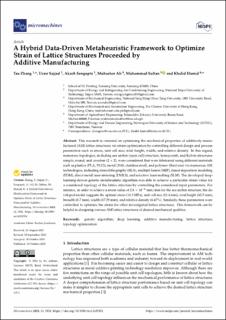| dc.description.abstract | This research is centered on optimizing the mechanical properties of additively manufactured (AM) lattice structures via strain optimization by controlling different design and process parameters such as stress, unit cell size, total height, width, and relative density. In this regard, numerous topologies, including sea urchin (open cell) structure, honeycomb, and Kelvin structures simple, round, and crossbar (2 × 2), were considered that were fabricated using different materials such as plastics (PLA, PA12), metal (316L stainless steel), and polymer (thiol-ene) via numerous AM technologies, including stereolithography (SLA), multijet fusion (MJF), fused deposition modeling (FDM), direct metal laser sintering (DMLS), and selective laser melting (SLM). The developed deep-learning-driven genetic metaheuristic algorithm was able to achieve a particular strain value for a considered topology of the lattice structure by controlling the considered input parameters. For instance, in order to achieve a strain value of 2.8 × 10−6 mm/mm for the sea urchin structure, the developed model suggests the optimal stress (11.9 MPa), unit cell size (11.4 mm), total height (42.5 mm), breadth (8.7 mm), width (17.29 mm), and relative density (6.67%). Similarly, these parameters were controlled to optimize the strain for other investigated lattice structures. This framework can be helpful in designing various AM lattice structures of desired mechanical qualities. | en_US |

